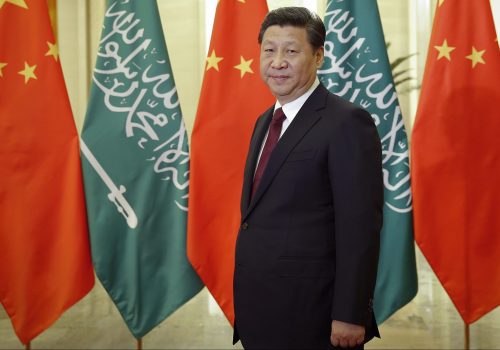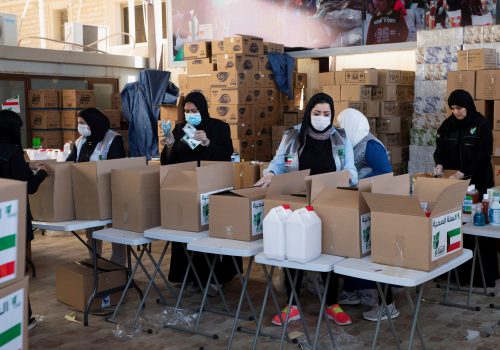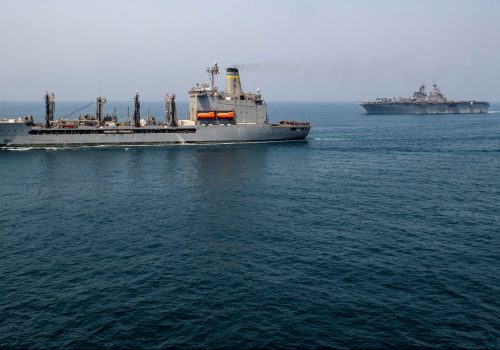Iran isn’t the only Middle Eastern country in a unique partnership with China
Last week’s dramatic report that China and Iran are close to completing a twenty-five-year trade and military partnership would appear to have significant geopolitical consequences for the Middle East. However, a closer look at the negotiations reveals more questions than answers. It would also be wise to consider the leaked details with a healthy dose of skepticism.
There are several points to consider about these partnership negotiations. First, this is not something new. China and Iran announced the comprehensive strategic partnership during Xi Jinping’s 2016 state visit to Tehran. This deal is not a response to the Trump administration’s “maximum pressure” campaign or deteriorations in the China-US relationship.
Another important point is that, while military and security cooperation are included in the leaked document, nothing mentioned is especially threatening to the United States or its allies in the Gulf. Specific bilateral cooperation discussed—joint training exercises and intelligence sharing—already take place. The focus on counterterrorism, trafficking, and transnational crime do not target a specific state and are common international concerns. This vaguely articulated bilateral cooperation will not threaten Gulf stability, at least in the near term.
Also important to consider is that there has been speculation about the partnership negotiations over the past year but it has been based on unnamed sources from the Iranian side. The Chinese government has had little if anything to say about the process. A Foreign Ministry press release covering the meetings between Foreign Ministers Wang Yi and his Iranian counterpart Mohammad Javad Zarif opened by referring to Tehran as a comprehensive strategic partner but focused on coronavirus and the Joint Comprehensive Plan of Action (JCPOA), saying nothing about the negotiations underway. The Shanghai Observer—not Xinhua or the People’s Daily, China’s papers of record—published a story but phrased it as “Iran’s recently announced twenty-five-year comprehensive cooperation plan.” It would be wise to wait for an official statement from Beijing before making judgements based on leaked documents from Iran.
Most important is that Iran is not unique in this type of partnership with China. Both Saudi Arabia and the United Arab Emirates (UAE) have comprehensive strategic partnership agreements and the parameters of these are being negotiated through committees co-chaired by senior officials on all sides. The China-Saudi partnership is being negotiated by a High Level Joint Committee co-chaired by Vice Premier Han Zheng and Crown Prince Mohammed bin Salman. The UAE is represented by the country’s first Special Presidential Envoy to China, Khaldoon al Mubarak. His counterpart is Yang Jiechi, one of the Communist Party of China’s (CCP’s) highest-ranking officials. He is a member of the twenty-five-person Politburo, which oversees the CCP, as well as the director of the Office of Foreign Affairs, was a former foreign minister, and is now also special representative to the UAE. That these men have been chosen to steer the bilateral relationships is a clear sign that they are serious partnerships for Beijing and that China is not going to cast them aside for whatever benefits a stronger relationship with Iran would offer.
Instead, China will attempt to continue its balanced approach to the Gulf and evidence of this could be found last week. While the China-Iran meetings were dominating headlines, the ninth China-Arab States Cooperation Forum (CASCF) Ministerial Meeting was underway, albeit virtually, in Jordan on July 6. This takes place every two years, bringing together the foreign ministers of all the Arab League states with their Chinese counterparts to map the next two years of cooperation. In the past, it has been used to introduce major initiatives.
While the ninth ministerial meeting in Jordan lacked any big ticket announcements, they signed three policy documents: a COVID-19 pledge of cooperation, an execution plan for the CASCF from 2020-2022, and the Amman Declaration, which “expresses the desire of China and Arab states to deepen relations. . . and reiterates mutual support on the issues of core interest and major concerns.” While China-Iran cooperation is not mentioned in the declaration, it was discussed during the meetings, according to a regional diplomat I recently spoke with.
This was followed by a conference on July 11, jointly hosted by the Chinese Academy of Social Sciences and the UAE’s Sharjah University, focusing on China-Middle East cooperation and the coronavirus crisis. Pointedly, Iran was not represented among Middle Eastern delegates, while several high-profile Arab participants were, including Saudi Prince Turki bin Faisal and former Egyptian Prime Minister Essam Sharif.
The significance of this is just to underscore that China has several balls in the air in the Middle East. It has deeply entrenched interests across the region and mature relationships with many relevant countries, most of which do not look favorably upon Iran. It is very unlikely that Beijing will be willing to overturn decades of diplomatic engagement and significantly larger volumes of trade and investment with these countries for deeper engagement with Iran.
This point about investment and trade is worth looking at more closely. Rumors that China will invest $400 billion into Iran have returned after being reported last year in a frequently-cited article from Petroleum Economist. The speculation is that China would supposedly invest $280 billion into Iran’s oil, gas, and petrochemical sectors and another $120 billion to upgrade its transport and manufacturing infrastructure.
As discussed in a response to the article by PhD candidate Jacopo Scita, who researches China-Iran relations, it is highly improbable that $400 billion of China’s overseas investment would go to a single country when the National Development and Reform Commission announced a 5-year Belt and Road Initiative investment projection of between $600 and $800 billion. In fact, its overseas investment and contracting have been declining since a peak in 2016, as Chinese state-owned enterprises are shying away from making large international transactions.
It would also represent an unfathomable transformation in the relationship—according to the American Enterprise Institute’s China Global Investment Tracker—as the value of Chinese contracting and investment in Iran since 2005 totals just under $27 billion. How this could increase nearly fifteen times needs to be explained, as does Iran’s ability to absorb that much investment in a short window of time.
The trade relationship has fallen far short of projections as well. During the 2016 visit, when the partnership was announced, the two countries forecast trade would reach $600 billion by 2026, up from just under $25 billion in 2016. While a return to sanctions has no doubt hurt trade, the volume has to explode in a hurry to reach that lofty goal; it was at $19 billion in 2019—its lowest number in a decade.
Furthermore, the question of any kind of financial infrastructure to facilitate this growth in the relationships has to also be addressed. China’s Bank of Kunlun has operated in Iran since 2006, providing an institution to facilitate trade and investment. The bank has proven sensitive to US sanctions, however, and earlier this year announced to its Iranian clients that after April 9th it would “no longer accept any business settlement in construction, mining, manufacturing, and textile industries,” limiting its services to “settlements involving humanitarian supplies and non-sanctioned industries.” This lack of financial institutional support is another reason to take the idea of massive transfusions of Chinese capital into the Iranian economy with a grain of salt.
In short, there is no question that the two countries are serious about each other and that this comprehensive strategic partnership is going forward. At the same time, it is not going to privilege Tehran at the expense of China’s other Gulf partners. Instead, expect a continued balanced approach as China pursues an interest-based regional agenda.
Jonathan Fulton is a nonresident senior fellow with the Atlantic Council. He is also an assistant professor of political science at Zayed University in Abu Dhabi. Follow him on Twitter: @jonathandfulton.
Image: Sheikh Mohammed bin Zayed al-Nahyan (L), Crown Prince of Abu Dhabi and UAE's deputy commander-in-chief of the armed forces meets Chinese President Xi Jinping (R) during a signing ceremony at the Great Hall of the People in Beijing on December 14, 2015. REUTERS/FRED DUFOUR/Pool



